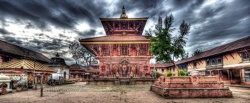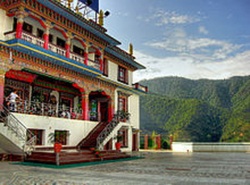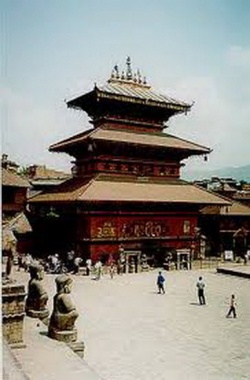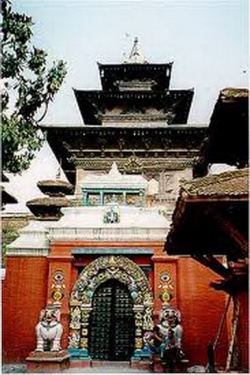A Portrait of Buddhism in Licchavi Nepal
by Charles M. Novak
The most noted characteristic of Buddhadharma as practiced by the Newars of Kathmandu Valley is that it has to a large extent preserved those forms of later Indian Buddhism known as Mahayana and Vajrayana in an unbroken, lining tradition. only recently Have scholars begun to explore the rich storehouse of /Buddhist traditions of Newari Buddhism from the point of view that it is an independent and unique tradition of Buddhism which deserves to be studied on its own merits. In order to better understand the background from which the complex socio-religious system of the Newar Buddhist community developed, the present article present to portray Buddhism as it developed in the kathmandu Valley during Nepal's Licchave Period )(ca. 300-879 A.D) Although, as much as possible, historically reliable Information has been used here, given the4 scantiness of historical references from this earliest period do Nepalese History and the author's desire to provide as complete a picture as is currently possible, some legendary material as well as reasonable supposition is included below.
Perhaps more so than most other places, the environment of the Kathmandu Valley has had a deep and abiding impact on the religious outlook of its people. The dramatic variety of physical features inspires awe: a central circular basin of just over 200 square miles surrounded by an uneven ring of high hills ranging from 6000 to over 9000 feet in height: vast forested areas on the hills and plently of fertile crop land in the lower areas which is drained by a web-like network of rivers and streams: spectacular sunrise and sunsets which sometimes include many show-capped Himalayan peaks. Most important from a religious point of view are the high hills and mountains in and around the Valley and other sacred locales (Skt; tirtha) which are often associated with bodies of water and are scattered throughout the Valley. From ancient times several of these prominent places have been venerated by the Buddhist population of Kathmandu Valley. Most important among these are: Swayambhu Hill, Nasgarjuna Hill, the mountains of Namobuddha and Manichuda places like cobar and Codavari that are associated with Manjusri Bodhisattva, as well as numerous sites around the Valley which are connected with Buddhist deities such as Mahakala, Taera, Vasudhara, Padmapani Bokhisattva in his several forms, Hariti and many places such as Guheswari, Bajrabarahi and the two shrines of vajrajogini which are related with the worship of female Buddhist deities known as yoginis. It is widely believed by the Newars and by most scholars that ancient sites such as these were held sacred even before the onset of strong cultural Influences from India, which started perhaps in the first or second century A.D. this early phase of cultural influence from India Corresponds roughly to the latter half of the Kushana Period and is most strongly felt throughout the Gupta period (ca. 300-550 A.D.). During this time, the old, indigenous place-names began to be replaced by Sanskrit, but the original named did not easily give way to the Sanskrit and some of these ancient Newari names survive even today.
The extent of the territories controlled by the Licchavi kings of Nepal is point that is still being debated from the fact that all but a handful of the Licchavi inscriptions are found in the Kathmandu Valley, it is obvious that this was the central and most important part of the Licchave domain. Fleeting and perhaps false references from the inscriptins have led scholars to believe that the Licchavis held sway over vast are as to the east and west of the Valley. Be that as it may, more important with regard to the study to Buddhism in Nepal are the cultural connections to the south with India's heartland and later on to the north with Tibet. For over a thousand years, from Kushana times until the early thirteenth century, Nepal received a steady flow of cultural Influences from India which were directly connected with Buddhism (and Hindusim). This includes the entirety of the Indian Buddhist tradition, with the notable exception of Pali Buddhism. It is only toward the end of the Licchavi period that Tibet begins to play a role a with regards to Buddhism, and that is mainly in the role of Patron to the Newar Buddhist artisans.
In a real sense, Licchavi Nepal can be seen as an evolving "Oasis" of Buddhist cultural traditions, An "Oasis" in the sense that all of the nearby, traditional centers of ancient Buddhism such as Vaisali, Sravasti, Sarnath, Kushinagara, Pataliputra, Lumbini and Kapilavastu had been abandoned bgy about 500 A.D., and Licchave Nepal was the only major cventer of Buddhism to the northest of Magadha for several hundred years, until the rise of Buddhism in Tibet. The ancient Buddhist centers mentioned above were (as today) Thought of only as places of pilgrimage, and not looked to as real sources of Buddhist teaching. This meant that the main centers of Indian Buddhism which served as important sources of Buddhist teaching. This meant that the main centers of Indian Buddhism which served as important sources for Licchave Nepal were especially the Nalanda/Rajgir/Bodhagya area, Mathur, perhaps pushpoagiri in Orissa, Tamralipti, Bharhut and even as far away as the western Indian swites of Ajanta, Ellora and Nasik. Wherever in India Buddhist Art forms and teachings might have come from, these found a warm welcome in Licchave Nepal and were cared for and developed with devotion and sensitivity.
Two forms of Buddhist worship which came into prominece during the Licchavi Period were the worship of the caitya or Stupa and the cart festival (or rath jatra) of Avalokitesvara. The many ancient sites within the Kathmandu Valley which are identified with major Buddhist caityas or Stupas such as Swayambhu Hill, Bauddha and Cabahil, Kathmandu and the four "Ashoka" Stupas of Patan not to mention the almost two hundred examples of stone caityas dating from the Lecchave Period, testify to the widespread antiquity of caitya worship. One can imagine that this practice in its earliest incarnation in the Valley was analogous to the worship of stones, which probably had its origin with the early, tribal inhabitants of the Valley lobng beforwe the coming of the Licchavis. According to one of the very earliest Licchavi inscriptions caitya worship could even involve encasing an existing Caitya and covering the new surface with many elaborate paintings, but ordinarily consisted of Ritual circummabulation of the caitya along with certain standard offerings such as Incense, colored powder, oil lamps and ablutions. Caitya worship must have been as important factor in bringing more and more of the trible, proto-Newar inhabitants into the Buddhist fold, since it was a devotional practice designed for the general public. Perhaps even more effective in involving the masses was (and is) the cart festival of Avalokitesvara/ Matsyendranath (Bunga kya:) which was probably begun during the latter half of the seventh century A.D. This festival was involved hundreds or even thousands of people in the process of the construction and transport of a huge, wheeled cart bearing the image of Avalokitesvara for several days or weeks along a prescribed route. This sort of festival must have been an instant success with the majority of the Valley's population and surely strengthened Buddhism's standing in relation to the other main religious faiths of the Valley at the time.
There are about forty stone inscriptions (Skt: silalekha) which make some mention of Buddhism throughout the Licchave Period and most of the references found in these inscriptions are concerned with Buddhist Monasteries and the Monks and nuns living therein. Even so, almost nothing can be said about the day-to-day Life in the Monasteries (skt: Vihara) or how they functioned administratively. The names of more than fifteen Budhist Monasteries are known, and it is clear from the contest in which some of these are named that they are among the most important religious foundations of the time. Although mothin definite is known about which Schools of Buddhism were most prominent, it is probable that the strongest early Influences (omitting mention of an even earlier probable substratum of Pali Buddhism) came from the Mahasanghika, Sammitiya and also the Sarvastivada, with the Makhyamaka and Yogacara schools of Thought being more influential later in the period with the emergence and growht of The Vajrayana. A tren which stands out from inscriptional evidence is that there was a string traditionsl of making religious gifts (Skt: deyadharma) for the sake of Merit and that the women of the Buddhist community seemed to take the lead in Offering these gifts. These last two elements find striking parallels in th Buddhist cave inscriptions of Maharastra which predata the Licchvi Nepal. The references in the Licchave inscriptions to the Mahayana and Vajrayana will be mentioned below in connection with Buddhist Art and notable Buddhist figures of the Licchave period.
In attempting to account for the Buddhist notables who date from Nepal's Licchave Period, we are entering the realm of legend, myth and unsure historical reference. Famous teachers and adepts from India such as Vasubandhu (the Younger?), the tantric Nagarjuna, Padmasambhava, Santiraksita and Kamalasila are said to have come to Kathmandu Valley in the service of Buddhism but none of these seems to have stayed for very long. As would be expected with such colorful figures as Nagarjuna, Padmasambhava and Vasubahdhu, their activities are identified with miraculous events, which tend to support the notion that tantric forms of Buddhism were present in the Valley at a very early stage, The Licchave inscriptions and later chronicles mention that several kings of the time such as Vrsadeve, Manadeve, Dharmadeva, Amusvarma, Narendradeva and Sivadeve I had very strong Buddhist associations but details are scanty. One important event which seems to have occured before 650 A.D. was the marriage of Bhirkuti, a Nepalese princess, to the king of Tibet. She is credited with having brought the Buddhasrma to Tibet and the translator Silamanju is said to have also bneen sent from Nepal to Tibet at this time in order to translate Buddhist texts. As we move into the last 200 yyears of olur period (ca. 700-879 A.D.), such shadowy figures as Santikara Acaruya and a few other adepts in the early phase of Vajrayana Buddhism are met with in Nepal. All in all, it is not possible to isolate recognized Buddhist schools of Thought by analysing this listing of Buddhist luminaries of Licchave Nepal, but one does suspect from this that Buddhism enjoyed a high status and a continuous tradition during the Licchavi Period.
Another interesting aspect deserving attention here concerns the matter of Buddhist texts in Licchavi Nepal. The Cabahil inscription of ca. 400 A.D. mentions the Kinnari Jataka and implies the currency of the Saddharmapundarika Sutra, but this is the solitary inscription of the period to mention Buddhist texts. From fragments of manuscripts which date from the eight and ninth centuries, it appears safe to say that the famed "Nine Dharma" texts of Nepal were well known in the Licchavi Period. This collection includes texts which represent Mahayana Buddhism in all its diversity, including the "Wisdom" school (Prajnaparmita texts). delineating the Bodhisattva path Dasabhumika and Samadhiraja Sutras), texts which are major classics of Mahayana devotion (Saddharmapudarika, Gandavyuha, Lalitavistara and suvarnaprabhasa Sutras) an imp0ortant text of the "Mind-only" school (Lankavatara Sutra) and perhaps the most fundamental text of The Vajrayana (Guhyasamaja Tantra). Considering the relative inaccessibility of the contents of this vast Body of Sanskrit literature to most of the Buddhist faithful, the practice of worshipping the "Nine Dharmad" texts in a ritualized manner was an adaption well-suited to the preliterate, tribal society of the proto-Newar communit6y of the Licchavi Period. It was probably not until the sixth or seventh century that the scholastic traditions of Indian Mahayana Buddhism started taking hold in the Kathmandu Valley, and the "Nine Dharma" collection should date from this time.
The final area to be mentioned in this exploration of Buddhism in Licchavi Nepal concerns the Buddhist Art and iconography of the time. The sculptural remains in stone and metal pore5tray a limited range of Buddhist artistic themes which are representative of the Mahayana in its full flower. The sculpturesillustrate seated and standing Buddhas, Bodhisattva Padmapani (Avalokitesvara), Vajrapani, Tara, Naitreya Buddha and the birth of Sakyamuni. In addition a few Tantric Buddhist deities such as Aksyobhya, Amitabha, Vajrayogini, Vajrabhairava, Usnisavijaya and Samantabhadra are known from the inscriptions, chronicles and Tibetan sources, In addition, it is certain that there was a strong ibfluence from Mother Goddess cults which resulted in Buddhist deities such as the Pancaraksas. The same can be said of Saivism in general, Sakta cults, Vaisnavism, Brahmanical cults and several other minor religious cults which muct have influenced the Buddhist iconography of Licchavi Nepal. The general impression one is left with is that the Buddhist Art of this period as a result of contact with the many religious cults coming from India which had found home in the Valley. On the whole, it seems that the Nepalese penchant for exotic, tantric iconography forms was tempered in the later Licchavi Period by religious conservativism, so that the more syntheric, tantrec Buddhist iconography does not fully emerge until after the Liccdhavi era had ended.
This brier survey of Buddhism in Licchavi Nepal indicated that the full-blown Form of Indian Mahayana Buddhism was transferred to the Kathmandu Valley during this early period. Certain elements such as the textual tradition, religious iconography the role of the Licchavi royalty and probably the architecture and administrative setup of the Buddhist Monasteries can be viewed as wholesale borrowings from India. On the other hand, the unique culture of the Kathmandu Valley shaped the actual expression of Buddhist Art and practice. This is evident from the sculptural remain so the time, as well as the development of caitya worship and the cart festivals. In general, the bulk of the evidence is suggestive of two major phases in the development of Buddhism in Nepal during the Licchavi Period. The first phase seems to run up to about the seventh century and is characterized by direct patterning after the Indian model of Mahayana Buddhism, which naturaly took several hundred years to be assimilated by the Valley culture. The second phase coincides with the coming of strong, new Influences such as the progressive rise of tantric cults and the beginnings of formal contacts with Tibet in the seventh century. Also by this time, many native elements of the fast-evolving proto-Newar culture of the valley were finding their way into the Buddhist fold. Consequently, as a result of the continuous and colorful tradition of Buddhism which evolved during Nepal's Licchavi Period, the stage was set for the unabated maturation of The Vajrayana Buddhist tradition in the centuries to follow.



